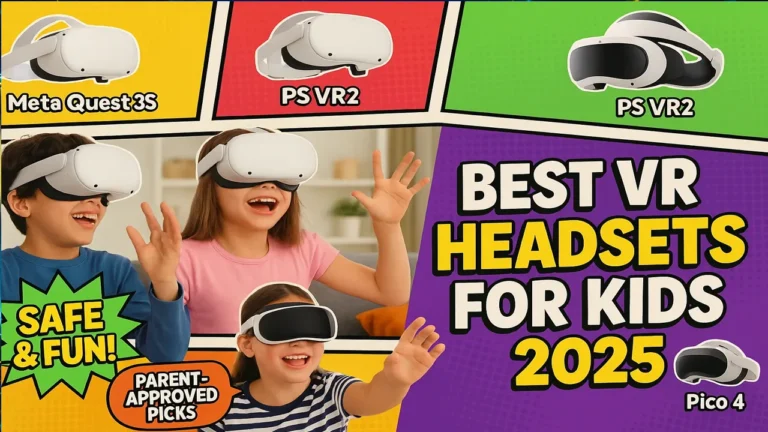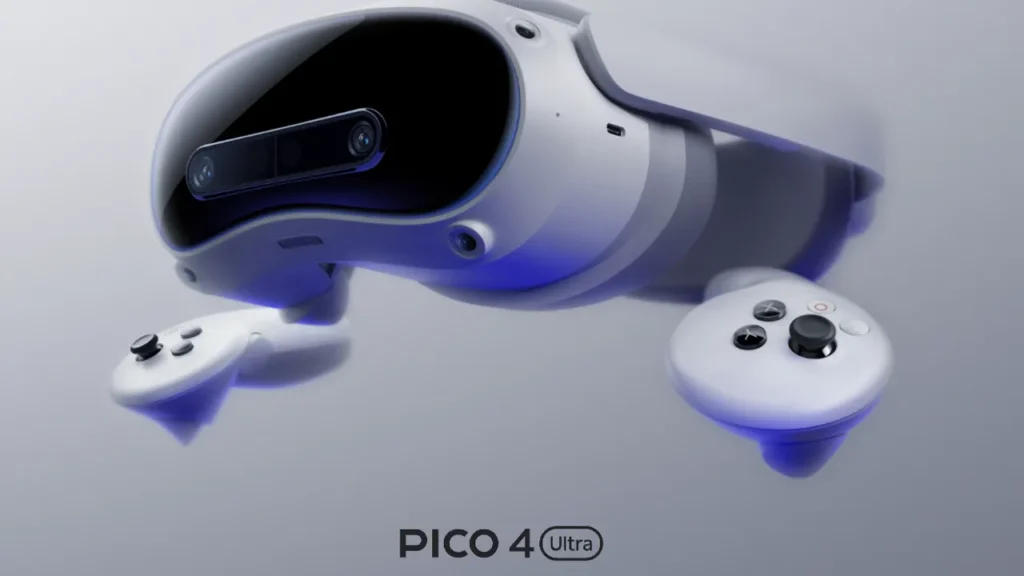Just a few years ago, virtual reality felt like something out of a sci-fi film. Today, my niece is jumping into colorful digital worlds and learning through VR apps—something unimaginable when I was her age. And while it’s impressive, it’s also taught me something important: not all virtual reality headsets are made for kids. Some are too heavy, others lack safety settings, and a few offer content not fit for younger minds.
That’s why, as part of the Cybernews team, we tested and reviewed the top VR devices available in 2025 to help parents make informed decisions. Whether your child is into gaming, educational apps, or social VR, this guide will walk you through the best virtual reality headset for kids, with safety and comfort as top priorities.
What is a Virtual Reality Headset for Kids?
A virtual reality (VR) headset is a device worn over the eyes that immerses users in a simulated 3D environment. For kids, this could mean diving into a digital dinosaur museum, exploring the solar system, or building virtual block cities. VR headsets for kids are typically lighter, simpler, and come with parental controls to ensure a safe experience.
Most headsets include:
-
A display screen or dual lenses
-
Built-in motion sensors
-
Handheld controllers
-
Adjustable straps and cushioning for comfort
Some headsets are tethered to PCs or consoles, while others run independently, known as standalone VR headsets.
Why VR is So Popular Among Young Users
Let’s be honest—kids love anything that feels futuristic. VR doesn’t just show them a screen; it puts them inside the experience. Whether it’s gaming, flying through space, or going on a digital treasure hunt, the interactivity is irresistible.
In our testing, younger users were consistently wowed by the immersion. But here’s the catch: comfort and safety are critical, and that’s what we focused on in this guide.
Are Virtual Reality Headsets Safe for Kids?
The short answer? Yes, but with the right supervision and equipment.
Manufacturers often recommend VR for children aged 10 to 12 and up. Their reasoning? Young eyes are still developing, and extended use can cause strain or discomfort. The good news is that modern headsets include blue light filters, play boundaries, and time limits to reduce these risks.
The key is balance—short sessions, open space, and age-appropriate content. Parental involvement transforms VR from a risk into a rewarding tool for fun and learning.
Virtual Reality Headset for Kids
Now let’s break down the best VR headsets available for kids in 2025. We ranked them based on comfort, ease of setup, parental features, and—of course—how much fun kids had with them.
Pimax Crystal Light – Best for High-Resolution Gaming
If your child is a budding gamer with access to a powerful PC, this is the premium option. With 130° field of view and QLED+mini-LED displays, the visuals are just… wow. It’s best for older kids (12+) due to its size and complexity.
Pros
-
Incredible visual clarity
-
Long-term investment
-
Wide view for immersive games
Cons
-
Requires high-end PC
-
Bulky for smaller faces
- Full-Payment Version: This is the full-payment option of the Pimax Crystal Light-SIM, offering the same premium features and exceptional quality without subscription-based upgrades or add-ons.
Meta Quest 3S – Best Standalone Option
No wires, no hassle—just pick up and play. Ideal for ages 10+, the Meta Quest 3S is a parent’s dream. The safety features like “Guardian mode” ensure kids don’t walk into walls while playing.
Pros
-
Wireless and lightweight
-
Large game library
-
Quick setup
Cons
-
Shorter battery life
-
Some games require extra purchase
- Transform your reality and do everything you love in totally new ways. Welcome to Meta Quest 3S. Now you can get the Batman: Arkham Shadow* and a 3-month trial of Meta Horizon+**
Sony PS VR2 – Best for PlayStation Gamers
If your family already owns a PS5, the PlayStation VR2 unlocks an exciting world. Kids can dive into 4K HDR graphics with haptic feedback. But it’s better suited to older kids, given its wired setup.
Pros
-
Stunning visuals
-
Seamless for PS5 gamers
-
Enhanced immersion
Cons
-
Limited to PlayStation use
-
Less freedom of movement
- PlayStation VR2 Sense technology: Eye tracking. Headset feedback. 3D Audio. Highly intuitive controls – Haptic Feedback, Adaptive Triggers and Finger Touch Detection
HTC Vive Pro 2 – Most Comfortable Design
Built with comfort and performance in mind, this PC VR headset is a hit for kids who love long gaming sessions. With a 120Hz refresh rate and soft padding, it’s as enjoyable as it is immersive.
Pros
-
High-resolution 5K display
-
Excellent weight balance
-
Smooth and stable performance
Cons
-
Setup takes time
-
Requires external base stations
- Visualize in 5K clarity-bring out the finer details with combined 4896 x 2448 resolution. 5K resolution may be subject to processing compatibility
Pico 4 Ultra – Lightweight & Kid-Friendly
This is the most child-centric headset we tested. It’s light, intuitive, and packed with safety controls. Perfect for ages 10 and up, it blends play with peace of mind for parents.
Pros
-
Kid-friendly UI
-
No PC needed
-
Includes parental controls
Cons
-
Smaller app library
-
Average battery life
- Lightweight and comfortable. Unique balanced design distributes weight evenly back and forth Experience the comfortable fit
Valve Index – Best Precision Tracking
The Valve Index delivers high-end performance and tracking accuracy that older teens (and parents) will appreciate. But be warned: it’s expensive and geared more towards hardcore VR users.
Pros
-
Exceptional hand tracking
-
Powerful hardware support
-
Great build quality
Cons
-
Pricey and complex
-
Not for younger users
- HEADSET ONLY. (MAY NOT INCLUDE HEAD STRAP ADJUSTMENT PAD). Controllers and base station purchased seperately
Comparison Table of the Best VR Headsets for Kids
| VR Headset | Type | Weight | Platform | Age | Best For |
|---|---|---|---|---|---|
| Pimax Crystal Light | PC VR | 815g | PC (SteamVR) | 12+ | Gaming visuals |
| Meta Quest 3S | Standalone | 514g | Quest/PC | 10+ | Easy setup |
| Sony PS VR2 | Console VR | 560g | PS5 | 12+ | PlayStation fans |
| HTC Vive Pro 2 | PC VR | 850g | PC (SteamVR) | 12+ | Comfort |
| Pico 4 Ultra | Standalone | 580g | Pico/PC | 10+ | Safety |
| Valve Index | PC VR | 809g | PC (SteamVR) | 12+ | Tracking |
Understanding the Types of VR Headsets
-
PC VR: High-quality, needs a powerful computer
-
Standalone VR: All-in-one, portable, and wireless
-
Console VR: Works with specific consoles like PS5
AR vs VR: What’s the Difference?
AR (Augmented Reality) adds to the real world. Think Pokémon GO.
VR (Virtual Reality) replaces it entirely. Think stepping into a game world.
AR is great for casual learning, while VR is for deep immersion and interaction.
Educational Value of VR for Kids
Kids can:
-
Walk inside the human body
-
Explore ancient Egypt
-
Conduct virtual science experiments
VR makes learning interactive, visual, and memorable.
Gaming Benefits in a Child’s Development
Surprisingly, gaming can help kids:
-
Improve hand-eye coordination
-
Solve complex problems
-
Build teamwork in multiplayer worlds
VR in Social Interaction and Community Building
Apps like VRChat or AltspaceVR let kids meet others in a monitored environment, encouraging communication, empathy, and even language skills.
Factors to Consider When Choosing a VR Headset
-
Age recommendation
-
Comfort and weight
-
Parental controls
-
Game library
-
PC/console requirements
-
Battery life
How to Use a Kids’ VR Headset Safely
-
Set time limits (20–30 minutes per session)
-
Ensure a clear play space
-
Activate parental settings
-
Supervise usage
-
Encourage breaks
Parental Controls and Content Management
Look for:
-
Screen time limits
-
Blocked app lists
-
Usage reports
-
Password controls for purchases
Top Features to Look For in a Kids’ VR Headset
-
Adjustable straps
-
Lightweight build
-
Soft eye padding
-
Blue light filters
-
Guardian mode
Common Concerns and Misconceptions About VR for Kids
Myth: VR damages eyesight.
Fact: Short, supervised sessions are considered safe.
Myth: VR is only for games.
Fact: Many educational apps exist!
What Age Should Kids Start Using VR?
Most manufacturers recommend 10+ or 12+, depending on the device. Younger kids should only use headsets under supervision.
VR vs Traditional Screen Time
VR is more engaging but should still be limited. Unlike passive screen time, VR encourages movement and interaction.
Tips for Managing Screen Time with VR
-
Use a timer
-
Combine VR time with educational apps
-
Encourage breaks and outdoor play
Final Word on Choosing a VR Headset for Kids
Choosing the right virtual reality headset for kids isn’t about picking the flashiest model—it’s about balancing fun, learning, and safety. From budget-friendly standalone units to high-performance gaming headsets, 2025 brings plenty of great options.
As a parent or guardian, your job is to guide the experience. Set time limits, monitor content, and stay involved. When used correctly, VR becomes more than just a gadget—it’s a gateway to a whole new way of learning, playing, and connecting.
FAQs
What age is appropriate for kids to start using VR headsets?
Most experts recommend starting around age 10–12, depending on the headset.
Are VR headsets safe for children?
Yes, with adult supervision, limited screen time, and proper content filters.
Which VR headset is best for gaming?
For casual gaming, Meta Quest 3S. For advanced players, PlayStation VR2 or Valve Index.
Can VR headsets be used for education?
Definitely. From science labs to history tours, VR has amazing learning apps.
Is VR better than traditional screen time?
It’s more interactive but needs time limits to be safe and healthy.
Do I need a PC to use VR?
Not always. Meta Quest 3S and Pico 4 Ultra are standalone and easy to use.












